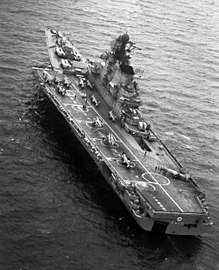Flight deck cruiser
A flight deck cruiser or helicopter cruiser is a type of warship that is primarily used for the use of aircraft and helicopters , but does not have a continuous flight deck .
history
Between the end of the First World War and the early 1920s, the first attempts to not only take off from a ship but also land on aircraft took place on board converted cruisers . The British HMS Furious is an example of this . Its two large turrets have been removed, making space for a front launch deck and an aft landing deck . The chimney and bridge structure remained in place. Landed aircraft had to be brought to the front for take-off (somewhat cumbersome).

During the Second World War , planes were carried by cruisers and capital ships in many navies, with the Japanese navy in particular leading the way. This development even went as far as the semi-conversion of battleships to so-called “hybrid aircraft carriers”. Here, the original superstructures and turrets were largely retained, but a flight deck was installed in the stern instead of the aft group of turrets. Up to 14 aircraft could then be taken, as the example of the Ise class , which was converted in 1943, shows.
present
With the introduction of helicopters and vertical take-offs for use on board warships, this concept revived during the Cold War. Since no catapult systems are required for take-off, there is no need for a continuous flight deck. The deck space gained is used for the installation of guns and guided missile launchers. Ships like the French Jeanne d'Arc , the British HMS Fearless and many amphibious support ships of the US Navy were given a distinctive appearance. The superstructure block and weapons have been moved forward, while the level flight deck connects to the aft with the hangar deck directly below .
The Italian aircraft carrier Giuseppe Garibaldi was declared a flight deck cruiser and used as a helicopter carrier until 1989 , as a post-war regulation forbade the Italian Navy to use aircraft.
Russian flight deck cruiser
The Soviet Union and Russia also refer to their aircraft carriers as flight deck cruisers, although they have a continuous flight deck. There are two reasons for this. On the one hand, this designation corresponds more to the armament and operational doctrine. In contrast to other modern aircraft carriers, the Soviet / Russian ships ( Kiev class , Admiral Kuznetsov class ) have relatively strong anti-ship armament. Second, they were classified to allow them to pass through the Dardanelles and the Bosphorus in accordance with the provisions of the Treaty of Montreux .
literature
Especially for the Russian flight deck cruisers:
- Maritime dictionary. Compiled by Jürgen Gebauer and Egon Krenz. Military publishing house of the German Democratic Republic, Berlin 1989, ISBN 3-327-00679-2 , pp. 115–118.
